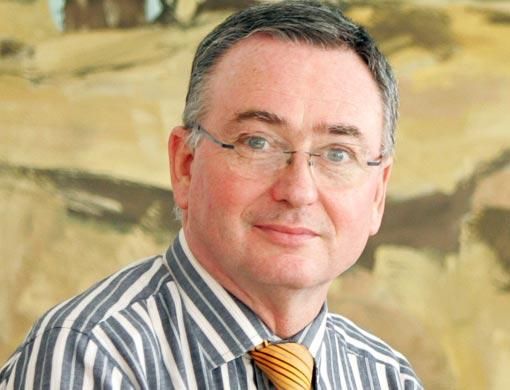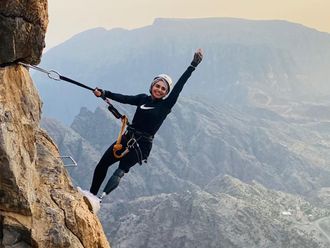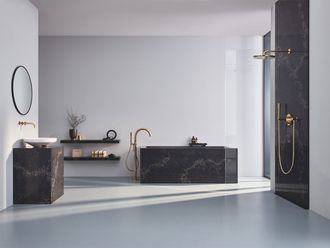Peter Jackson is passionate about preserving the past. The chairman of the English chapter of the UAE Architectural Society tells Shiva Kumar Thekkepat that the UAE, and Sharjah in particular, has a strong cultural ethos which he is privileged to help preserve.
At first sight, Peter Jackson appears to be just another tourist soaking in the sights of an exotic Middle Eastern city. He blends into the background of a gaggle of history and architecture buffs who form the English-speaking chapter of the UAE Architectural Heritage Society. On a recent sunny morning, they're viewing the ruins of an old house on the Sharjah Corniche.
A quintessential British national, Peter is the chairman of the society and if you follow the group for a while, you'll find the members seeking his guidance at almost every turn.
A highly respected co-author of Windtower: Houses of Bastaki (Stacey International), and a socially conscious, environmentally aware architect, this mild-mannered man believes in standing by his principles rather than following trends blindly.
The fact that he was invited to work for the Ruler's Office in Sharjah is a testimony to his commitment to preserve historical architecture. Friday joined his group for a short tour recently:
I
I have two shared passions: one is good architecture and design, and the other is history. Another important strand in my life has been friendships. My life has been enriched through friendships.
I enjoy travel, and have travelled quite a lot in my life. Not just as a tourist, but living and working in interesting and different places. I have enjoyed trying to define the character of buildings appropriate to their environment.
I believe one of the key skills architects can bring to their trade is that of analysis and problem-solving. I emphasise the latter because I am convinced that poor design creates more problems!
Architects are multi-disciplined; generalists rather than specialists. We learn to manage many skills – our own and those of the specialists. Engineers tend to be more specialised than architects, like surgeons as opposed to general physicians. An architect's skills are more diverse.
It probably has to do with the nature of design. It is difficult to pin down exactly what is good design or what isn't. It begins during training, when we study a large number of disparate subjects, from the artistic to the scientific, each a discipline and a career in its own right.
I was about 13 when I decided I wanted to be an architect. I had a strong interest in history, and since the age of six or seven used to drag my parents on holiday trips looking for prehistoric tombs and Roman ruins, often around the moors of northeast England where my family hails from.
I come from a very close-knit family. My parents returned to Dubai for the first time in 35 years this February to celebrate their diamond wedding anniversary. All their grandchildren attended, including our youngest son from Australia, and my sister who was in Dubai in the early 70s.
It has been family support and contribution that has enabled me to research and write while pursuing a full-time job. I couldn't have managed it all on my own.
I've designed many schools in my life and I've always thought that it is much more important to design schools for people, than design it as an institution. If you're designing a primary or middle school you've got to think of the scale of the building for small people as opposed to adults.
Me
Me and my beginning
I was born shortly after the end of the Second World War in England and brought up in one of the new towns north of London.
As a child it was interesting to experience a town growing around me. Hatfield wasn't an attractive place and it had only one sustaining industry, the De Havilland aircraft company. When the fortunes of that company changed, so did the fortunes of the town.
I went to school in the nearby city of St Albans for which I developed a strong affection. It was a historic town with a beautiful cathedral abbey, plenty Roman remains and a long architectural history and development.
I enjoyed my school years at the boys grammar school where I did my O levels. My two main subjects for A levels were art and maths – two different subjects, but ideal for architecture. I used to enjoy going to the park where there were Roman remains and walls to sketch and draw. It was a long walk from the school so I was always looking at the buildings
I passed. My father was a civil engineer, and my mother had trained as a nurse.
Me and architecture
From my early teens, I started working with an architect during weekends and school holidays. By the time I went to university I was a capable draughtsman. I studied architecture at London University just at the point when my parents moved to Jeddah in Saudi Arabia.
It was only after my father moved to Dubai in 1971, that I came out to visit them. During my practical year-out from college in 1972, I was at a point where I was so frustrated with the work I was doing that I was wondering whether to continue [in the career] or not.
I found working at a London drawing office quite difficult to deal with after having worked in a small practice during school holidays.
While here, I ended up working with John R. Harris Architects, who were supervising construction of the new Rashid Hospital. I spent six marvellous weeks looking after smaller scale projects including a bank and a private house.
I returned to England fascinated by this part of the world and with my enthusiasm for architecture rekindled. John Harris had asked if I would return to join the practice after finishing my degree, so I tailored my final diploma project to doing so.
As a subject I chose low-cost housing. I designed a scheme in the desert – at Al Wasl! Because of my father's experience and contacts, I was able to make a quite an in-depth study of Dubai as a context for the project.
In doing so I became more interested in the different cultures of the Gulf region, which I found rich and stimulating.
I met Dr Anne Coles at university while I was finishing my desert housing project. Anne, a social geographer who had lived in Dubai, was asked by my department to assist me as a tutor for my work.
She took my project completely apart, totally devastating me at the time, but it made me look at architecture in a very different way; we became good friends.
Me and Dubai
After obtaining my RIBA (Royal Institute of British Architects) qualification with John Harris, the firm sent me here to look after their office for six weeks when one of the partners went on leave. What a fantastic opportunity for personal
and professional development!
On one of my trips to Dubai for John Harris, Anne asked whether I would do a drawing of a windtower for Dubai Museum.
This resulted in my carrying out a measured survey of a windtower house. I was assisted by a teenager in my task: Rashad Bukhas. Today, Rashad is the director of Architectural Heritage Projects at Dubai Municipality, and officiates as Chairman of the UAE Architectural Heritage Society.
That technical drawing resulted in a small publication in 1975, A Windtower House in Dubai. It brought together the two threads of history and architecture for me, and it introduced a third, which has become equally important to me – that of people.
How people use buildings, how they live in them, how building as a product of our human values. This was in strong contrast to an increasingly contemporary view of buildings as objects and fashion statements.
Me and Zambia
I then had an opportunity to work in Zambia, central Africa.
I went there intending to stay for two years, but ended up staying for four. I got married and with the imminent birth of a son, my wife Jutta and I had to decide where we were to make a home.
In early 1980, Zimbabwe celebrated its independence. A colleague and I formed our own practice in Salisbury, which became Harare. Over the next 22 years, we went through a number of changes and partners, but remained a strong practice. We were commissioned for a good number of schools, houses, housing schemes, mixed-use projects, offices and health work. We also carried out projects in Botswana and Mozambique.
We also focused on rural projects, social housing, schools and markets. I was doing very interesting work with museums, at very sensitive sites with ancient rock paintings, and at 19th-century Zulu settlements, integrating interpretive centres into very sensitive environments.
Myself
How did you meet your wife, Jutta?
Jutta is German and we first met while still at school, rather appropriately at a conference in Germany on International Understanding. As teenagers we naturally went our separate ways after keeping in touch through letters for five years. We managed to meet again 10 years later while I was in Zambia.
I was briefly in England, travelling back from a trip to Mexico, to find a letter from my former pen-friend. I flew to Hanover for the weekend to see her again. Two days later we were engaged and in six months we married! Jutta, a teacher, joined me in Zambia.
Both our sons, Oliver and Karsten, were born in Zimbabwe and grew up there.
Why did you leave Zimbabwe?
Seven years ago, with a changing economic and political situation, I became very concerned about our future welfare. I renewed old contacts, and returned to Dubai in 2002. I had been a principal in my own business for 22 years.
I had been working very modestly within a relatively poor context, and most of our work had been socially based.
After Rashad and I met each other again, I realised that one of the things I should do was continue the research that Anne and I had started years ago.
If we didn't capture memories of the older families while they were still there, a part of UAE history could easily be lost. So, Anne introduced me to her friends from the '60s. We received huge support from the Bastaki community who thought it was worthwhile to capture their history in a book.
So our research expanded to become a major project and Windtower: Houses of Bastaki was published late last year.
Then came an offer to work for the Ruler's Office in Sharjah, a privilege.
How did you get involved in the UAE Architectural Heritage Society?
The society that Rashad had established in 2002 was originally solely Arabic-speaking. Rashad saw a role for an English-speaking chapter, and asked if I would join a committee he was putting together.
I was elected chairman. At that time Dubai was the only working committee. We established a regular programme of monthly lectures and field trips to complement the activities of the larger Arabic-speaking group.
Initially the society explored sites in the UAE but now we explore Oman, East and North Africa and India. The more we look at our local architecture, the more we can learn from subtle differences because buildings were so locally based and dependent on materials and skills in that particular settlement.
How do we preserve the past, so that it's not a museum experience but an interactive one, and ensure that our preserved buildings are useful?
Buildings need to be used, lived in, not only preserved as museums. They are resources to be recycled. That's the richness of old cities. How many uses have those old buildings in central London gone through or the centre of Mumbai or the old colonial cities of Melbourne or Cape Town? This is cultural and environmental sustainability, as opposed to the throwaway society.
What is so special about working in Sharjah?
Sharjah has a very strong cultural ethos. The authorities have strong concerns for culture and education. We are not fighting to preserve buildings here; it's part of what Sharjah does and has been doing for 18 years.
His Highness Dr Shaikh Sultan Bin Mohammed Al Qasimi, Supreme Council Member and Ruler of Sharjah, cares passionately for the history of his Emirate.
He wants the memory of the past to be kept alive. Without that memory, our children and grandchildren are going to be less and less connected to the environment. That same theme came through when studying the Bastakiya.
Families expressed concern that their children knew little of the lives of their grandparents or great grandparents.











